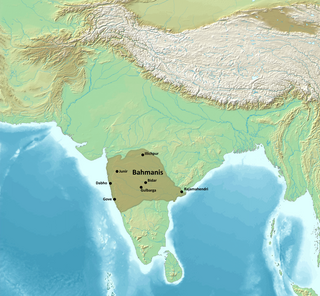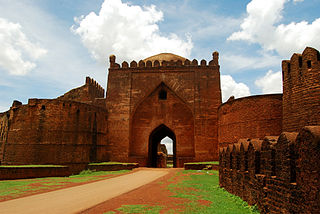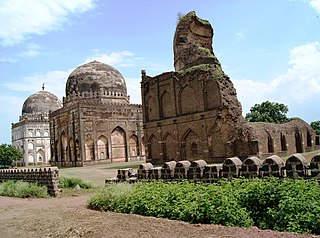
The Deccan Sultanates were five late-medieval Indian kingdoms—on the Deccan Plateau between the Krishna River and the Vindhya Range—that were ruled by Muslim dynasties: namely Ahmadnagar, Berar, Bidar, Bijapur, and Golconda. The sultanates had become independent during the break-up of the Bahmani Sultanate. The five sultanates owed their existence to the declaration of independence of Ahmadnagar in 1490, followed by Bijapur and Berar in the same year. Golconda became independent in 1518, and Bidar in 1528.

The Bahmani Sultanate was a Muslim empire that ruled the Deccan Plateau in South India. The Bahmani Sultanate came to power in 1347 during the Rebellion of Ismail Mukh after Ismail Mukh abdicated in favour of Zafar Khan, who would establish the Bahmani Sultanate. The Bahmani Sultanate was in perpetual war with its neighbors, including its rival, the Vijayanagara Empire.

Bidar (/biːd̪ər/) is a city in the north-eastern part of Karnataka state in India. It is the headquarters of Bidar district, which borders Maharashtra and Telangana. It is a rapidly urbanising city in the wider Bidar Metropolitan area. The city is well known for its many sites of architectural, historical and religious importance. Bidar City have a population of more than 2 lakh and are likely to get upgraded to municipal corporation in the next 5 years.

The Qutb Shahi dynasty was a Persianate Shia Islamic dynasty of Turkoman origin that ruled the Sultanate of Golkonda in southern India. After the collapse of the Bahmani Sultanate, the Qutb Shahi dynasty was established in 1512 AD by Sultan-Quli Qutb-ul-Mulk, better known though less correctly referred to in English as "Quli Qutb Shah".

Ibrahim Qutb Shah Wali, also known by his Telugu names Malki BhaRama and Ibharama Chakravarti, was the fourth monarch of the kingdom of Golconda in southern India. He was the first of the Qutb Shahi dynasty to use the title "Sultan". He ruled from 1550 to 1580. He lived for seven years in exile at the court of Vijayanagara as an honoured guest of Rama Raya. Ibrahim is known for patronizing Telugu extensively because he was moved by a genuine love for the language.

The Adil Shahi or Adilshahi, was a Shia, and later Sunni Muslim, dynasty founded by Yusuf Adil Shah, that ruled the Sultanate of Bijapur, centred on present-day Bijapur district, Karnataka in India, in the Western area of the Deccan region of Southern India from 1489 to 1686. Bijapur had been a province of the Bahmani Sultanate (1347–1518), and member of the Deccan Sultanates, before its political decline in the last quarter of the 15th century and eventual break-up in 1518. The Bijapur Sultanate was fully absorbed into the Mughal Empire on 12 September 1686, after its conquest by the Emperor Aurangzeb.

Rama Raya was a statesman of the Vijayanagara Empire, the son-in-law of Emperor Krishna Deva Raya and the progenitor of the Aravidu dynasty of Vijayanagara Empire, the fourth and last dynasty of the empire. As a regent, he was the de facto ruler of the empire from 1542 to 1565, although legally the emperor during this period was Sadasiva Raya, who was merely a puppet ruler. Rama Raya was killed at the Battle of Talikota, after which the Vijayanagara Empire got fragmented into several semi-independent principalities paying only nominal allegiance to the empire.

The Battle of Talikota, also known as that of Rakkasagi–Tangadagi, was a watershed battle fought between the Vijayanagara Empire and an alliance of the Deccan sultanates. Despite the Vijayanagara army being larger, they were comprehensively defeated. The battle resulted in the defeat and death of Rama Raya, the de facto ruler of the Vijayanagara Empire, which led to the immediate collapse of the Vijayanagara polity and reconfigured South Indian and Deccan politics.

Bidar sultanate was one of the Deccan sultanates of late medieval southern India. The sultanate emerged under the rule of Qasim Barid I in 1492 and leadership passed to his sons. Starting from the 1580s, a wave of successions occurred in the rulership of the dynasty which ended in 1609 under the last Sultan Amir Barid III who was eventually defeated in 1619 by the Bijapur sultan Ibrahim Adil Shah II. Bidar became annexed into the Bijapur Sultanate.
Qasim Barid I was prime-minister of the Bahmani sultanate and the founder of the Bidar Sultanate, one of the five late medieval Indian kingdoms together known as the Deccan sultanates.

The Ahmadnagar Sultanate or the Nizam Shahi Sultanate was a late medieval Indian Muslim kingdom located in the northwestern Deccan, between the sultanates of Gujarat and Bijapur, ruled by the Nizam Shahi or Bahri dynasty. Malik Ahmed, the Bahmani governor of Junnar after defeating the Bahmani army led by general Jahangir Khan on 28 May 1490 declared independence and established the Nizam Shahi dynasty rule over the sultanate of Ahmednagar. Initially his capital was in the town of Junnar with its fort, later renamed Shivneri. In 1494, the foundation was laid for the new capital Ahmadnagar. In 1636 Aurangzeb, then Mugal viceroy of Deccan, finally annexed the sultanate to the Mughal Empire.

Bidar Fort is located in old city area, Bidar, Karnataka, India. The fort, the city and the district are all affixed with the name Bidar. Sultan Ahmad Shah I of the Bahmanid dynasty shifted his capital from Gulbarga to Bidar in 1427 and built his fort along with a number of Islamic monuments. There are over 30 monuments inside Bidar fort.
Bidar is a historic place located in the north-eastern part of the South Indian state of Karnataka. Bidar enjoys a picturesque situation, having been situated and built on the brink of a plateau, and thus commanding lovely views of the lowlands (talghat) towards the north and the east. Its latitude is 17°55'N., its longitude 77°32' E., and the height above the sea-level 2,330 feet (710 m). The climate is bracing and the temperature in the hottest season does not usually rise above 105 °F (41 °C). The Bidar plateau is an irregular oblong, 22 miles (35 km) in length and 12 miles (19 km) in extreme breadth.

Deccani Architecture refers to the architectural styles developed during the Deccan sultanate period. The Deccan sultanates were five dynasties that ruled late medieval kingdoms, namely, Bijapur, Golkonda, Ahmadnagar, Bidar, and Berar in south-western India. The Deccan sultanates were located on the Deccan Plateau. Their architecture was a regional variant of Indo-Islamic architecture, heavily influenced by the styles of the Delhi Sultanate and later Mughal architecture, but sometimes also directly from Persia and Central Asia.
Mahmood Shah or Shihab-Ud-Din Mahmud was the sultan of the Bahmani Sultanate from 1482 until his death in 1518. His long rule is noted for the disintegration of the sultanate and the creation of the independent Deccan sultanates.

The Barid Shahi tombs are tombs of the Barid Shahi dynasty. They are located in Bidar in the Indian state of Karnataka.

The Bahmani tombs complex at Bidar is the necropolis of the Bahmani dynasty, located in Bidar, in the Indian state of Karnataka.
Amir Barid I, also known as Amir Ali Barid was the second ruling member of the Barid Shahi dynasty.

The Deccan Sultanates-Vijayanagar Conflicts were a prolonged period of military conflict lasting from 1495 to 1614 A.D. This series of battles pitted the rival powers of the Deccan Sultanates against the Vijayanagar Empire. Over the course of approximately 120 years, these two entities engaged in a series of wars and skirmishes that were marked by significant displays of military strength and strategic maneuvering.














